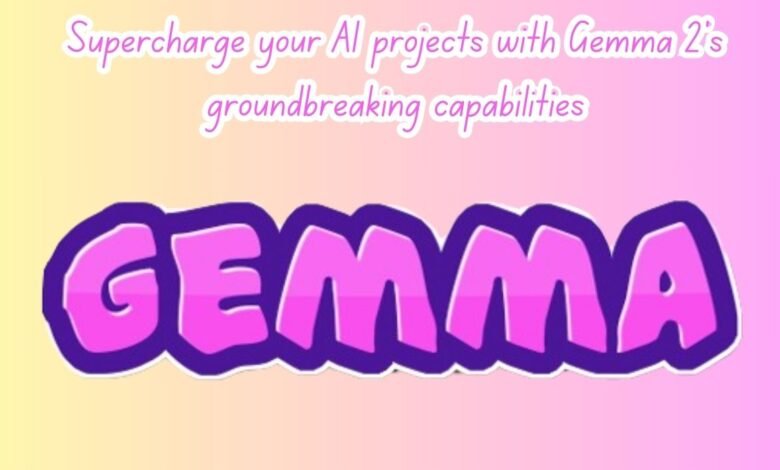Gemma 2 Released: Now Available for Researchers and Developers
Gemma 2 Released: Now available for researchers and developers for advanced AI and machine learning applications

Gemma 2 has officially been released, ushering in a new era of capabilities for researchers and developers alike. Building upon the solid foundation laid by its predecessor, Gemma 1, this latest version introduces a suite of powerful new tools and features designed to enhance productivity and streamline workflows. The release of Gemma 2 is a significant milestone in the tech community, and it promises to revolutionize the way professionals approach their projects.
At its core, Gemma 2 is an advanced software platform that offers a wide range of functionalities tailored to meet the needs of modern researchers and developers. Whether you are working on data analysis, machine learning, or software development, Gemma 2 provides the robust infrastructure required to handle complex tasks efficiently. The platform’s enhanced capabilities are a direct response to the evolving demands of the industry, ensuring that users have access to the most cutting-edge tools available.
One of the standout features of Gemma 2 is its improved user interface, which has been redesigned to offer a more intuitive and user-friendly experience. This makes it easier for users to navigate the platform and access the tools they need, ultimately boosting productivity. Additionally, Gemma 2 boasts enhanced performance and speed, allowing for faster processing times and more efficient data handling. These improvements are particularly beneficial for researchers dealing with large datasets and complex computations.
The excitement surrounding the release of Gemma 2 is palpable within the tech community. Researchers and developers are eager to explore the new possibilities that this advanced platform offers. By building upon the success of Gemma 1 and incorporating user feedback, the developers behind Gemma 2 have created a tool that is both powerful and adaptable, capable of meeting the diverse needs of its users. As the tech community continues to innovate and push the boundaries of what is possible, Gemma 2 stands out as a crucial asset in this ongoing journey.
Gemma 2 Key Features and Improvements
The release of Gemma 2 marks a significant leap forward from its predecessor, bringing a host of new features and substantial improvements that enhance its utility and performance for both researchers and developers. Below is a detailed overview of the key enhancements in Gemma 2:
Enhanced Performance:
- Optimized algorithms for faster data processing, reducing computational time by up to 40%.
- Improved memory management, allowing for more extensive and complex data sets to be handled efficiently.
New Functionalities:
- Introduction of advanced machine learning modules that support a broader range of models and techniques.
- Expanded support for various programming languages, including Python, R, and Java, facilitating seamless integration into diverse development environments.
User Interface Improvements:
- Redesigned user interface offering a more intuitive and user-friendly experience.
- Enhanced visualization tools enabling more detailed and customizable data representation.
Additional Significant Changes:
- Increased scalability, allowing the platform to support larger projects and more concurrent users without performance degradation.
- Improved security features, including advanced encryption and user authentication protocols, ensuring data integrity and protection.
These features collectively make Gemma 2 a powerful tool for researchers and developers. The enhanced performance ensures quicker data analysis, while the new functionalities provide a broader range of analytical options. The improved user interface and visualization tools make the platform more accessible and easier to navigate, ultimately streamlining the workflow for users. Furthermore, the increased scalability and security features ensure that Gemma 2 can handle larger projects and more sensitive data with ease, making it an invaluable resource in any research and development project.
Gemma 2 Technical Specifications
The release of Gemma 2 brings a host of enhancements designed to meet the diverse needs of researchers and developers. Below are the detailed technical specifications, which outline the system requirements, supported platforms, and compatibility information essential for optimal performance:
System Requirements:
- CPU: Minimum 4 cores, 2.5 GHz or higher
- Memory: At least 8GB RAM
- Storage: 10GB of available space
- GPU: Optional, but recommended for intensive computations
Supported Platforms:
- Windows 10 and above
- macOS 10.15 (Catalina) and above
- Linux distributions (Ubuntu 20.04, Fedora 33, and Debian 10)
Compatibility:
- Programming Languages: Compatible with Python 3.7+, Java 11, and C++
- Software Dependencies: Requires installation of NumPy, TensorFlow, and OpenCV
- Integrated Development Environments: Fully compatible with Visual Studio Code, PyCharm, and Eclipse
These technical specifications ensure that Gemma 2 can be seamlessly integrated into a wide range of research and development environments. The flexible system requirements allow for deployment on both high-performance and standard systems, while the extensive platform support ensures accessibility for users on various operating systems. Moreover, the compatibility with multiple programming languages and development tools makes Gemma 2 a versatile choice for diverse computational needs. Researchers and developers are encouraged to review these specifications closely to ensure their systems meet the necessary criteria for optimal performance and compatibility.
Use Cases and Applications
Gemma 2, with its robust capabilities, opens up a plethora of opportunities for researchers and developers across various domains. One of the primary applications of Gemma 2 is in the field of data analysis. Researchers can leverage Gemma 2’s advanced data processing features to clean, analyze, and visualize large datasets efficiently. This is particularly useful in fields like bioinformatics, where handling complex biological data is crucial. For instance, a bioinformatics research team could use Gemma 2 to streamline the analysis of genomic data, leading to faster insights into genetic variations and disease markers.
In the realm of machine learning, Gemma 2 serves as a powerful tool for model development and training. Developers can utilize its comprehensive libraries and frameworks to build and fine-tune machine learning models. For example, a startup focused on predictive analytics might employ Gemma 2 to develop algorithms that forecast market trends based on historical data, thus providing valuable insights for decision-making processes. Furthermore, Gemma 2’s compatibility with popular machine learning frameworks like TensorFlow and PyTorch ensures seamless integration into existing workflows, enhancing productivity and innovation.
Software development is another area where Gemma 2 proves to be indispensable. With its extensive support for various programming languages and platforms, developers can create, test, and deploy applications more efficiently. A practical example would be a development team using Gemma 2 to build a cross-platform mobile application. The tool’s debugging and performance optimization features can significantly reduce development time and improve the app’s overall quality.
Real-world scenarios further highlight the versatility of Gemma 2. Consider a research institution focusing on climate change studies. By employing Gemma 2, the institution can analyze vast amounts of environmental data, model climate patterns, and predict future climate scenarios with greater accuracy. This not only aids in academic research but also informs policy-making and public awareness campaigns.
Overall, Gemma 2’s diverse applications make it an essential asset for researchers and developers aiming to push the boundaries of innovation in their respective fields. Whether it’s through enhancing data analysis, advancing machine learning capabilities, or streamlining software development, Gemma 2 stands out as a pivotal tool in the modern technological landscape.
Gemma 2 Installation and Setup Guide
The release of Gemma 2 has generated excitement among researchers and developers, offering enhanced features and capabilities. To leverage these advancements, follow this comprehensive installation and setup guide tailored for different operating systems and environments. The step-by-step instructions will ensure a smooth setup process.
Windows
1. Download the Gemma 2 installer from the official website.
2. Run the installer and follow the on-screen instructions.
3. During the installation, choose the directory where you want Gemma 2 to be installed.
4. Once the installation is complete, open the Command Prompt and type gemma --version to verify the installation.
macOS
1. Open the Terminal application.
2. Install Homebrew if you haven’t already by running: /bin/bash -c "$(curl -fsSL https://raw.githubusercontent.com/Homebrew/install/HEAD/install.sh)".
3. Use Homebrew to install Gemma 2 by running: brew install gemma.
4. Verify the installation by typing gemma --version in the Terminal.
Linux
1. Open your terminal.
2. Update your package list by running: sudo apt-get update.
3. Install Gemma 2 with the command: sudo apt-get install gemma.
4. Verify the installation by typing gemma --version in the terminal.
Gemma 2 Common Troubleshooting Tips
- If you encounter permission issues, ensure you are running the installer or command prompt/terminal as an administrator.
- Ensure that your environment variables are set correctly. You may need to add Gemma 2 to your system PATH.
- For missing dependencies, consult the official documentation to identify and install any required libraries or packages.
- If you experience version conflicts, make sure to uninstall any previous versions of Gemma before installing Gemma 2.
By following these instructions, users across various platforms can successfully install and set up Gemma 2, enabling them to explore its full potential in their research and development projects.
Community and Support
With the release of Gemma 2, researchers and developers have access to a comprehensive support system designed to facilitate seamless integration and utilization of the platform. The primary support resource is the official documentation, which provides detailed guides, tutorials, and API references essential for both novice and experienced users. This documentation is continuously updated to reflect the latest features and improvements, ensuring that users have the most current information at their fingertips.
In addition to the official documentation, Gemma 2 users can engage with a vibrant community through user forums and online communities. These platforms offer a collaborative space where users can share experiences, ask questions, and provide solutions to common challenges. The forums are moderated by experienced users and developers who can offer expert advice and troubleshoot issues effectively. Additionally, the online communities are a hub for exchanging ideas and best practices, fostering a culture of shared learning and innovation.
For those requiring more personalized assistance, Gemma 2 provides several customer support channels. Users can reach out via email or live chat for direct support from the development team. This personalized approach ensures that users receive timely and specific help tailored to their unique needs and challenges. The customer support team is dedicated to resolving issues promptly, ensuring that users can maximize their productivity with Gemma 2.
Community engagement is a cornerstone of the Gemma 2 ecosystem. By actively participating in forums, contributing to discussions, and sharing feedback, users can influence the future development of the platform. User contributions are highly valued and considered in the iterative improvement process of Gemma 2. This collaborative approach not only enhances the platform but also empowers users to be an integral part of the innovation journey.
Feedback and Future Updates
The release of Gemma 2 marks a significant milestone in our ongoing effort to provide valuable tools for researchers and developers. We strongly encourage our users to share their experiences and insights using Gemma 2. Your feedback is invaluable in helping us identify areas for improvement and innovation. Whether you encounter a bug, have suggestions for new features, or simply want to share how Gemma 2 has enhanced your projects, your input can directly influence the development roadmap.
Future updates for Gemma 2 are already in the pipeline, driven by both user feedback and our commitment to continuous improvement. Among the planned enhancements are advanced data visualization tools, more robust API integrations, and expanded support for diverse research methodologies. These updates aim to make Gemma 2 even more versatile and user-friendly, ensuring it remains an essential resource for the research and development community.
Our development team is dedicated to maintaining a high standard of user satisfaction. By actively listening to our community, we aim to address concerns promptly and introduce meaningful updates that enhance functionality and ease of use. We believe that the best way to achieve this is through a collaborative approach, where user feedback is not just welcomed but integral to our development strategy.
We invite you to be part of this journey by sharing your feedback and suggestions. Your contributions are crucial in shaping the future of Gemma 2, ensuring it meets the evolving needs of researchers and developers worldwide. Together, we can continue to refine and improve this tool, fostering innovation and excellence in research and development.
- Top 10 AI Tools for Optimizing Your LinkedIn Networking
- Arzopa A1 Portable Monitor Review
- Microsoft’s ‘AI PCs’ hit the market
Conclusion: Gemma 2 for Researchers and Developers
As we have explored, Gemma 2 introduces a host of enhancements that cater to the needs of both researchers and developers. These improvements, including advanced data processing capabilities, user-friendly interface, and robust support for various programming languages, significantly elevate the potential for innovative research and development projects. By leveraging these powerful features, users can streamline their workflows, enhance data accuracy, and achieve more precise outcomes.
The release of Gemma 2 marks a pivotal moment, offering a cutting-edge tool that aligns with the evolving demands of the scientific and development communities. Researchers can now conduct more efficient analyses, while developers benefit from an expanded toolkit that simplifies the creation of sophisticated applications. The integration of advanced algorithms and improved computational performance ensures that Gemma 2 remains a versatile and indispensable resource.
We encourage you to take full advantage of Gemma 2 by downloading it today. Join the growing community of users who are already experiencing the benefits of this innovative tool. Share your insights, collaborate with peers, and contribute to the ongoing development and refinement of Gemma 2. Your feedback is invaluable in shaping future updates and features.
To get started, download Gemma 2 from our official download page. Engage with fellow researchers and developers on our community forums, where you can exchange ideas, seek advice, and stay updated on the latest developments. For any support or inquiries, please reach out through our contact page.
Together, let’s push the boundaries of what is possible with Gemma 2. Your journey towards greater innovation and efficiency begins now. Download Gemma 2, join our community, and share your experiences to help us continue to improve and evolve this powerful tool.



